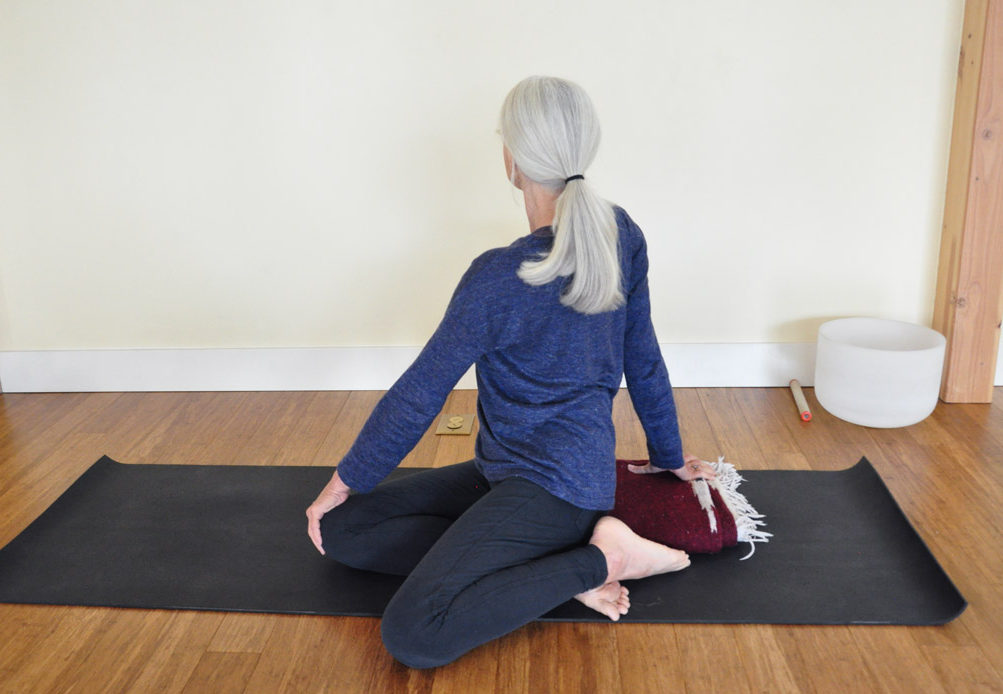
The heroes of yoga’s ancient texts appear in many of its asanas. Most of these heroes (and heroines) take the form of gods and goddesses. Revered sages have also been honored with poses all their own. The pose I’d like to feature today, Bharadvajasana, is named in honor of Bharadvaja, a famous sage in the Ramayana. Here’s how Zo Newell, author of Downward Dogs and Warriors: Wisdom Tales for Modern Yogis, tells the story of Bharadvaja:
“Bharadvaja was a rishi, an ancient sage—one of the famous Seven Sages of Vedic times, who are immortalized in the constellation known in India as the Sapta Rishis and in Western astronomy as the Seven Sisters. The epic Ramayana tells us that when Lord Rama (the hero of the Ramayana and an incarnation of Lord Vishnu, the preserver) entered into exile, he found refuge in the ashrams of several sages. The first of these sages was Bharadvaja, who was living in the forest practicing austerities, and surrounded by his students.”
According to the Ramayana, Bharadvaja visualized washing Rama’s feet daily for most of his long life. When Rama finally appeared to him, asking for shelter, Bharadvaja was able finally to wash the feet of his master in person. It is said that he became “supremely happy.”
Like other poses named after sages, Bharadvajasana is a spinal twist. I’m not sure why seated twists are often honored with sagacious names, but it’s definitely a pattern. Perhaps it is related to the nadis—ida and pingala—the energetic channels that spiral through the torso from the pelvic floor to the top of the head.
At any rate, like most spinal twists, Bharadvajasana mobilizes the thoracic spine, massages your abdominal organs, increases hip and shoulder flexibility and can help relieve low back pain. Like all spinal twists, it is not a good idea to practice this pose during the first trimester of pregnancy. I enjoy the fact that this pose is not a “bound” twist. Unlike twists such as Ardha Matsyendrasana (named after another sage), there’s nothing in front of the abdomen, so it’s easy to move and breathe freely.
How to Practice Bharadvajasana
- Sit on a yoga mat with your legs outstretched in front of you.
- Shift weight to your right buttock and bend your knees, so that your feet rest next to your left buttock.
- Place the top of your left foot onto the arch of your right foot.
- Root your right ischial tuberosity (sit bone) into the floor as you lengthen your spine upward.
- Place your right hand on the floor next to your right hip. Press your hand into the floor to help you lengthen your spine.
- Place your left hand on your right knee and gently rotate your shoulders and head to the right, keeping your shoulders relaxed. Make sure that your left hand is not forcing you into the twist. Allow your twist to be relaxed enough that you can feel your torso oscillating as you breathe.
- If you like, you can place your right forearm behind your back and reach for the crook of your left elbow. If this movement causes your spine to round, move your hand back to the floor next to your right buttock.
- You may also place the fingers of your left hand under your right thigh (as in the photo) if it doesn’t cause your spine to round forward.
- Take five to ten deep, relaxing breaths.
- On an exhalation, slowly unwind. Stretch your legs out in front of you and then repeat on the other side.
If sitting with your legs to the side is difficult, place a folded yoga blanket under your hips. Also if reaching your hand to the floor is challenging, you can place a yoga block under your hand.
The myth behind Bharadvajasana suggests that diligent daily practice may someday yield the fruits we’d hoped for. While our skeletal structures may not support our ability to practice every single pose—especially the “fancy” ones—we can learn to practice with ease and grace. With committed practice, our asanas, no matter what they look like, can become effortless. And maybe in that release of effort, we can find “supreme happiness.”
